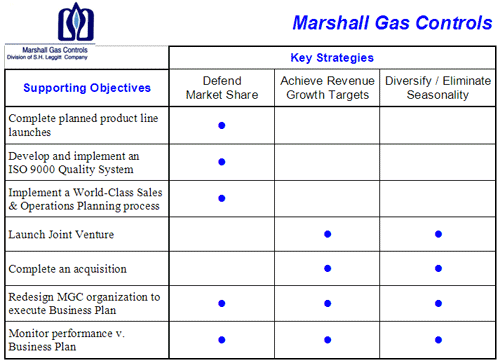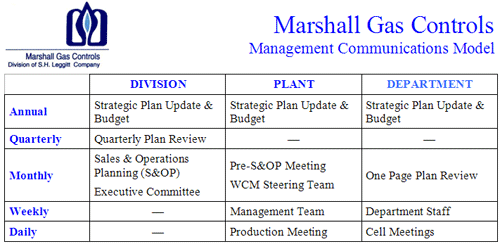 |
 |
|||
|
|
Home > Our Clients > Case Studies > Marshall Gas Controls MARSHALL GAS CONTROLS
Marshall Gas Controls, in San Marcos, Texas is the leading producer of gas regulators for the outdoor cooking and RV markets. The business is extremely seasonal with almost all of the business distributed through the first 3 quarters of each year. The company is family owned – third generation Don Leggitt, Jr. is President; the management team has long tenure and is very experienced. MCG is similar in many ways to the entrepreneurial organization that has built their business by focusing on customer service. Prior to TCA’s involvement, MGC did not have a strategic plan – the executive team managed the company using an annual plan and budget. MGC had never needed a strategic plan, and from all appearances could continue to be successful in existing markets without one. However, the management team recognized that market share increases in current markets were unlikely. Continued growth would have to come through diversification. For that, MGC needed a Strategic Business Plan. Preferring the word “Master” to “Strategic”, Marshall Gas Control’s Master Business Plan is an incredible document. It took several weeks to work through all the elements. All department managers have this document on their desk and refer to it frequently. Tim Nicholson, Operations Vice President, keeps his copy in a 3-ring binder in order to make changes and access easier. He uses this document every week. It is a living document and changes as business changes. Market/Economic Factors, SWOT, Objectives The Executive Team met for 2 concentrated off-site days to develop the market data, Strength-Weakness-Opportunities-Threats (SWOT) analysis, mission/values statement, financial objectives, key strategies, and supporting objectives. Members of the management team generated most of the supporting data. The team also prepared an easy to read, simplified summary of the company’s financial objectives. The summary showed sales, growth, and other key fiscal data for a 5 year period. This process ensured all members of the executive team had the information fresh in their minds while considering strategies for the future. High-Level Strategies The next step is crucial. The MGC's management team looked at this information as a whole and asked themselves, “What must our strategies be in order to accomplish the opportunities or negate the threats?” From this analysis, several overall key strategies emerged:
Supporting Objectives and Implementation Plans With key strategies in hand, the executive team then asked, “What must our supporting objectives be in order to execute on the strategies?” MGC developed a list of supporting objectives:
Using key strategies and supporting objectives, each department manager then developed specific implementation plans. This step is often left out in many business plans yet it is the most important step in execution. Each manager outlined in detail what he or she was going to do to achieve the supporting objectives. In many cases, the manager had to coordinate decisions about priorities, resources, and other issues with the executive team. This process was very constructive and resulted in meaningful implementation plans. Driving Implementation With 1Page Plans The executive team used the 1 page plan as the key tool to drive the implementation of the Master Business Plan. For each department, a 1 page plan summarizes key strategies, departmental objectives, and implementation tasks. These included a brief statement, due dates, and individual responsibilities. 1 page plans are reviewed and updated monthly, and tie all the efforts in each department back to the Master Business Plan. Gap Analysis – Organization and Communication The final step of the planning process was to recognize that the new Master Business Plan required changes in the company’s organization structure and in other planning processes used by MGC. As part of the Master Business Plan, a communications model and an organization structure were developed.
The Communications Model outlined the meetings that would be used to plan future performance and to monitor performance against plan. It also defined specific agendas and responsibilities for each planning meeting. Other changes to the organization structure became part of the implementation plan and are being completed along with other elements of the plan. Conclusion All companies can develop a strategic business plan. Marshall Gas Controls found that to make it work, they had to:
Using these tools and techniques, Marshall Gas Controls is effectively executing against the plan and achieving significant growth in new markets. Contact Us for a Free Assessment!
|
||
|
|
 Strategic
Business Plans Can Be Successful
Strategic
Business Plans Can Be Successful
